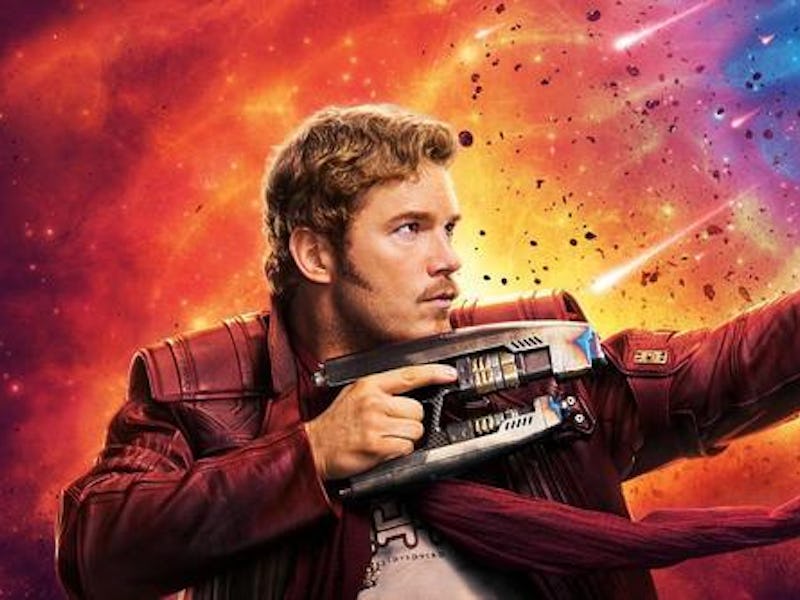Chris Pratt Flew a Real Jet Pack in ‘Guardians of the Galaxy Vol. 2’
There's a surprising abundance of practical effects in the latest Marvel spectacle.

Amongst the many charming scenes in writer/director James Gunn’s Guardians of the Galaxy Vol. 2, two stand out in particular: the opening credits battle against a giant space monster set to ELO’s “Mr. Blue Sky” and the big climactic battle in which Rocket Raccoon searches for some scotch tape while Baby Groot toddles off with a dangerous bomb detonator. Both scenes find our heroes soaring about on jet packs, and while a stunt like that would seem like an obvious contender for total CGI rendering, those jet packs were very much real.
“The jet packs are practical rigs that we created at Legacy Effects, based on concepts done by the Visual Development team at Marvel,” Lindsay Macgowan and Shane Mahan, co-owner of Legacy, told Inverse via e-mail.
The practical effects — including much of the intensive alien makeup — for Guardians of the Galaxy Vol. 2 were handled by Legacy Effects, a Hollywood-based studio with credits on films like The Jungle Book and X-Men Apocalypse. Working on Gunn’s movie allowed them to flex creative muscles and solve problems other films might not even trigger.
Gamora (Zoe Saldana) with her jet pack.
“The stunt team rigged the actors and stunt performers once the jet packs were on them, and they were then connected to fly-wires so that they could be ‘flown’ down,” Macgowan and Mahan explained. “The jet packs were very versatile and could be adjusted for different sizes of actors when needed. Gamora has a very specific version made just for her, as she was the only female character wearing the rig.”
The jet packs and spaceships flown by the characters were designed by Marvel’s in-house Visual Development team and Scott Chambliss, the production designer on Guardians of the Galaxy Vol. 2. Though Chambliss was new to the Guardians series, he was no stranger to sci-fi design; he’s probably most famous for production design work on J.J. Abrams’s Star Trek in 2009 and Star Trek Into Darkness in 2013.
Although Chambliss “inherited” some of the spaceship design from production designer Charles Wood’s work on the first movie, he told Inverse that he “took some liberties” with the exterior of the Eclector, the primary spaceship used by Yondu and the Ravagers. When designing new spaceships — like fighters used by the gold-skinned Sovereign aliens — Chambliss said he tries “to approach each new ship design with a fresh eye,” as difficult as that can be in a saturated genre. However, Chambliss was quick to point out that designs from the starship Enterprise would have no place in the Andromeda Galaxy. “Any similarity of Galaxy to Trek would do the Guardians a serious disservice!” he said.
A surprising standout among the Guardians this time around is Star-Lord’s adoptive “daddy,” the outlaw Ravager Yondu (Michael Rooker), who has essentially been elevated to a major character in Vol. 2. Because fans are doubtlessly already preparing their Yondu cosplays for upcoming comic cons, Macgowan and Mahan had some insight into how Yondu’s awesome, new mechanical mohawk was actually made. “The actual mohawks are made of different materials,” they revealed.
“The stunt version is cast in a flexible urethane, and the hero actor’s version is a material that has been rapid prototyped in a material that is semi-clear. We tinted the grown part to match the coloring of the design. We then added some LED lights inside the mohawks so that they would have some added life to them on set.” This means that the glowing effect of the mohawk in the movie is, at least partially, a practical effect not achieved solely in the computer.
The vast majority of Guardians of the Galaxy Vol. 2’s optical effects were created by the famous Weta Workshop, but the movie wouldn’t have gotten there in the first place without the practical effects. Obviously, most of Baby Groot is CGI in the final film, but Legacy created a hard Baby Groot maquette and a poseable Baby Groot as a lighting stand-in.
Macgowan and Mahan also highlighted the efforts of the make-up specialists who had to bring their designs to life — over and over again.
Karen Gillan as Nebula
“One of the biggest challenges for these make-ups is the humidity in Atlanta,” they explained. “So you have to maintain the look of the character throughout the day’s shoot.” The make-up for the characters of Gamora (Zoe Saldana) and Nebula (Karen Gillan) took three and three-and-a-half hours, respectively, to apply. And though Gillan famously had to shave her head for the first Guardians, that wasn’t the case this time around. “Karen didn’t shave her whole head,” Macgowan and Mahan explained. “We integrated new techniques to allow her to be able to keep her long hair for this movie.”
Obviously, no one at Legacy constructed a planet-sized Celestial God Kurt Russell for the movie, but the immense attention to detail on Guardians of the Galaxy Vol. 2 makes you think that everyone involved would have, if they could have.
Guardians of the Galaxy Vol. 2 is out in wide release now.